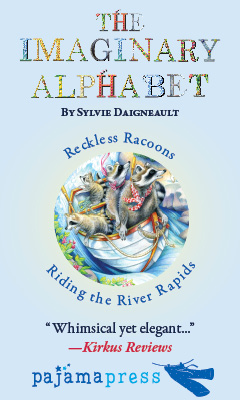The Imaginary Alphabet
by Sylvie Daigneault
A menagerie of merry and meticulously embellished animals mingles with witty wordsmithing and a whimsical search-and-find component to create an extravagant abecedary for an extensive audience in Sylvie Daigneault's glorious, oversized picture book, The Imaginary Alphabet.
A quick glance at the cover piques curiosity, but a careful look tips off readers to the treasures in store. Fairies and frogs flank a fancy pair of ferrets--one ferret flaunting a feathered fascinator and clutching a fan in front of her flouncy gown, and the other looking fetching in a foulard and fustian formalwear. A fountain (housing a verdant fern) burbles behind them while flames flicker from nearby flambeaux. Five flowers rest at their feet. Daigneault frames the vignette with gold-foil mounting corners, as if the moment were captured for a photograph in an album. The scene is outrageously detailed, slightly absurd, and simply fun. And it is one of 26 such sophisticated scenes awaiting attentive readers within this elaborate alphabet storybook.
A brief phrase announces the primary animal, descriptor, and action, but readers can find in the paired illustration as many as 20 items beginning with the featured letter. "Agile Alligators Attempting an Arabesque" appear, dancing beneath an arch adorned with acorns upon which sit albatrosses. "Lazy Lemurs Licking Lemon Lollipops" sit atop a log by a lakeshore with a ladle at one's feet for their lemonade, as lilies grow nearby. In a rollicking spread with the sensibilities of Bruce Degan's Jamberry, "Reckless Raccoons Riding the River Rapids" crouch in a rowboat as a reindeer, a robin, and raspberry-munching rabbits flank the rolling river, with a rain cloud storming in the distance. The featured animals span an impressive array of size, skin, or fur texture, and varying degrees of likely familiarity to young readers. Descriptive vocabulary includes words like "clumsy," "orchestrating," and "velvety," and strikes a playfully erudite tone without veering into pretentiousness.
From those arabesquing alligators to a stampede of zippy zebras, Daigneault crafts fantastical scenes with attention to the tiniest detail. Each letter of the alphabet gets its own page: an intricately illuminated single initial on the left page proffers an object to locate in the accompanying animal illustration on the right. While "J" is drawn entirely of jellybeans, and jostled jellybeans feature prominently in the paired image of jumping jackrabbits, other illuminations spotlight more challenging clues. Knots of twisted rope wind their way through the "K" page, but the kite's tail they reference is a subtle element of the koalas' detailed orchard scene. Remarkably, Daigneault manages an equally complex illustration for that generally vexing animal abecedary obstacle--the letter X--focusing on the xerus, an African ground squirrel, with xenops birds above. The careful selection of animals and paired objects, all outside of their natural environs while feigning a convincing normalcy, is immersive, and the frisky sentence setting each scene melds beautifully with the artwork's spirited aesthetic.
The Imaginary Alphabet is not Daigneault's first abecedary--she illustrated C Is for Canada: Celebrating Our Nation in 2017--and her illustrative work for other children's books dates back decades (Sarah Saw a Blue Macaw, 1991). For this, her first book as author/artist, Daigneault spent nearly four years on the illustrations. Her commitment is evident in the details. She uses layers of colored pencil, digitally enhanced, to achieve her attentive artwork. Dedicated animal abecedary readers may liken this intricate, fantastical effort to Graeme Base's Animalia (1987), a classic of the genre. Daigneault's expansive and powerful use of white space allows her delicately shaded, jewel-toned drawings to pop on the page. As with Base's jam-packed rendition, a generous trim size nicely showcases this mid-century modern art. The search-and-find details extend the creation's appeal to an older audience than abecedaries typically enjoy.
Daigneault welcomes the audience in a preface that frames the story as "about nature and... filled with joy and magic for readers of all ages." In her effort "to present each letter with panache" she tucks "just under 300 little gems to be discovered" that start with the same letter as the one featured in the large illustrations. These letter-inspired objects and actions are listed, letter by illuminated letter, in an end section titled "Discover Sylvie's Alphabet World." The ornamental alphabet also appears on both the front and back endpapers.
The Imaginary Alphabet is quite a feat. Its artwork feels elegant and spacious while sustaining a fanciful tone with childish appeal. Its limited lexicon is sophisticated enough to satisfy linguists while still approachable for its intended audience of early and emerging readers. Animal lovers and I Spy series enthusiasts, especially those who appreciate elaborate detail in picture book art, should find special joy in perusing these pages. This ornate, alliterative, and interactive alphabetical adventure invites discovery as it delights admirers with its eccentric animal reveries. This is a dreamy addition to personal shelves and library collections. --Kit Ballenger








